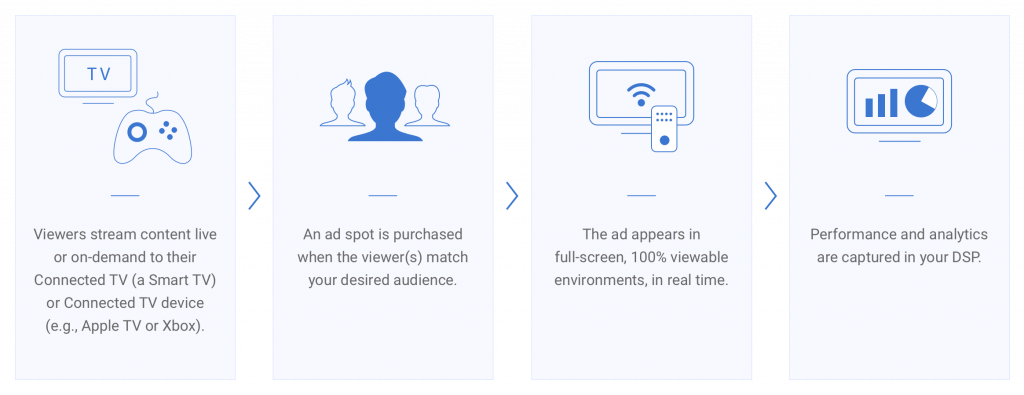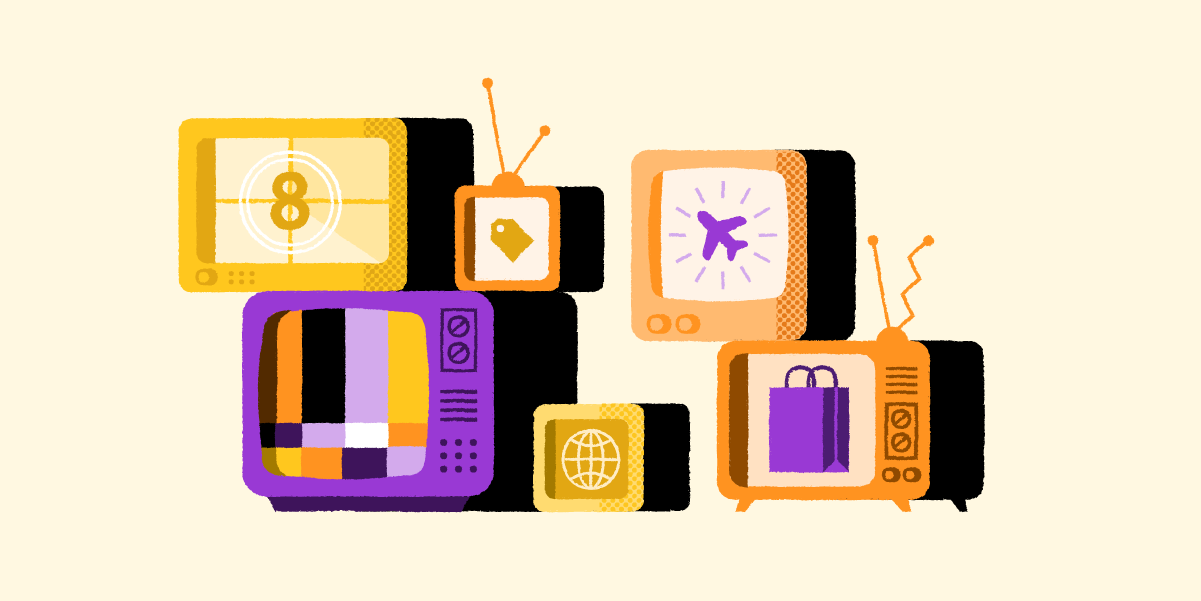What is CTV, and why should you care? The shortest answer to both questions is: it’s currently the way 213.7 million viewers of your potential target audience are choosing to watch their favourite shows.
By official definition, connected TV is the device that connects to your subscription streaming service. Netflix, Hulu, and Amazon Prime are all delivery methods for streaming content. Those platforms connect to CTV devices like Roku, PlayStation, Xbox, Amazon Fire Stick, Google Chromecast, Apple TV and more. A massive amount of your target audience, across all demographics and verticals, is consuming their content via OTT and CTV channels.
What’s more, the growth of what CTV means in advertising has changed the way advertisers need to think about commercial breaks. It’s no longer necessary for viewers to wait through 30-second commercial breaks. They can watch what they want when they want it. The structure of the “commercial break” as we know it has transformed.
Many advertisers might be concerned with such a major disruption to the “playing field.” However, the silver lining in all of this is that CTV gives advertisers access to something they’ve always wanted: more data. With the advent of streaming services and CTV, advertisers can gain a much deeper understanding of what motivates their customers. This gives the modern advertising professional an unprecedented advantage.
It’s time to leverage the data and analytics CTV can provide to elevate your advertising success. It’s time to learn how to make the modern commercial break work for you.
What Is CTV
So, what is connected TV? CTV refers to the devices used to stream internet content. This could be a Smart TV, mobile phone, or tablet. To use CTV, subscribers pay a monthly fee to a video-on-demand (VOD) service like Netflix or Hulu, download the app, and access their programming through that particular platform.
It’s important to note that although apps like Netflix and Hulu are an integral part of the CTV process, they aren’t CTV themselves. CTV strictly refers to the device used as a conduit for streaming content. Those devices can be:
- Smart TVs: Any TV with an internal media platform and internet connection. A great “rule of thumb” is that no additional equipment should be necessary to stream on a Smart TV.
- Consoles: In particular, gaming consoles. Platforms like Xbox, PlayStation, and Nintendo Switch all contain app stores. Here, users can purchase and stream digital content to their TVs.
- Connected Device: These devices attach directly to your TV and are connected to the internet. Examples would be Roku, an Amazon Fire Stick, or Apple TV. These devices are sometimes referred to as OTT devices and provide streaming capabilities to your TV, whether it’s a Smart TV or not.
CTV is a Subset of OTT
If you run a Google search for “what is connected TV advertising,” you may see the terms “CTV” and “OTT” interchangeably. In actuality, CTV is a subset of OTT advertising.
OTT is the delivery method for internet TV services. It’s called OTT because it goes “over the top of” traditional network providers. In short, CTV is the device and OTT is the delivery method.
How Did We Get Here?
Historically, your target audience would be gathered around their TV set anxiously awaiting their favourite show at 9:00 pm on a Tuesday night. During this time, Nielsen families would log their viewing habits into their diaries and these numbers are what the big-time “Mad Men” agencies of the early advertising era would use to make their media-buying decisions.
The result was TV advertising as we know it: ads for beers, cars and brokerage firms during Sunday football and ads for psychic readings and debt consolidation during the 3 am timeslot.
This type of advertising relied heavily on the viewer. Most families were fully aware of the day and time of their favourite shows. Now, things are much different.
Most individuals under the age of 30 have no idea what day or time their favourite shows are on, nor do they need to. Today’s viewers watch programming whenever and wherever they want via one of the half-dozen streaming devices in the average American home.
The way viewers consume their shows has changed as well. Viewers don’t want to wait for one weekly installment of their shows. They will likely watch every episode of the newest season in one sitting before moving to an entirely different show. Consumers now control the day, time and screen. And, since CTV has changed the way people watch, we need to change how we advertise.
How Does Connected TV Advertising Work
Connected TV advertising, by definition, consists of any type of TV that can be connected to the internet and can stream digital video at a viewer’s convenience.
If you’re wondering how CTV advertising works, it’s slightly different from traditional linear TV. CTV ads are sold as impressions on a particular audience that streams content on demand. Ad spots are brought when a viewer fits into your desired audience. They will then receive your creative messaging in full-screen, completely-viewable environments.
Leveraging the Benefits of Connected TV
You need to think of CTV as a complement, not a replacement. CTV’s advertising benefits should be used as part of a larger, holistic campaign.
Some of the key benefits offered by CTV are:
- Increased accessibility.
- Lower barrier of entry.
- More effective budget allocation.
- Deeper insights through more granular data and metrics.

The benefits listed above represent the true power of CTV advertising, and you can see how it fits into an overall holistic approach in the graphic above. However, it’s important to note that linear TV has not, and will not be fully abandoned in favour of CTV just yet. As a result, marketers used to advertising on linear TV will be best served by media strategies that combine both platforms.
Common Challenges of CTV Advertising
Although CTV is an effective platform, there are some drawbacks advertisers need to be aware of:
1. Fragmented Inventory
Advertising via CTV channels presents an almost unlimited number of suppliers. Media buyers are constantly facing the challenge of where to place their clients’ ads. With platforms like Roku, Fire Stick, and Chromecast all vying for consumer attention, ad inventory can easily get fragmented across a wide array of platforms.
2. Inconsistent Campaign Metrics
Inventory fragmentation can lead to challenging CTV measurement. Each platform has its own set of metrics and data, in direct contrast to running ads on linear TV.
Linear ad spots rely heavily on the Nielsen ratings. While it’s nice to have the extra data and insights CTV offers, some advertisers prefer the ease of comparing all campaigns to one performance metric.
3. Complex Campaign Management
There is no shortage of online streaming platforms. Everyone you talk to has their own go-to provider for their favourite shows. While advertising on these platforms is effective, simultaneously managing campaigns on various platforms can become a full-time job.
CTV in Action
Making CTV work for you doesn’t just hinge on finding the right audience. Ensuring you’re targeting the proper industry with your advertising is an equally important part of the puzzle.
Leading advertising providers are beginning to offer this service for clients in a wide array of industries. CTV for healthcare, CTV for sports and CTV political ads are all on the rise and other industries will quickly pick up on this trend as viewers opt for more streaming services in their homes.
The Future of CTV
What is CTV’s evolving role in the overall advertising landscape? With technology growing rapidly and disrupting the way things are done in industries across the board, viewers will constantly be presented with a growing number of devices and platforms to interact with. As a result, the evolution of CTV is moving toward a more holistic campaign approach.
CTV is rapidly becoming a larger part of the overall TV advertising market share. Therefore, championing this platform and getting out in front of your team’s CTV misconceptions is becoming more and more important. Success in the future will come from leveraging this platform to meet your audience where they are – in both their customer journey and on the device they choose.
CTV With StackAdapt
For now, using a holistic approach to your campaigns gives you a competitive advantage. But eventually, the day will come when what CTV is fundamentally changes, and a holistic approach is an absolute necessity.
StackAdapt prepares you for this future by offering you innovative features and AI technology to help you apply a unique approach to your CTV advertising. Typical challenges like fragmented CTV measurement, finding the right CTV ad creatives for your message or audience, and campaign management can all be resolved in one easy-to-use platform.
Now is the time to figure out “what is CTV’s role in our overall marketing plan?” For more information on how to onboard CTV with StackAdapt, request a demo.
FAQ
What does CTV stand for?
CTV stands for connected TV.
What is connected TV advertising?
Connected TV advertising is ads delivered through CTV platforms like Roku, Amazon Fire Stick, gaming consoles, and Smart TVs.
How does connected TV advertising work?
CTV ads get sold as impressions. Companies bid on viewers in their target audience who stream content on demand through a variety of channels. Ad spots are purchased when a viewer matches the company’s ideal customer. Your creative will then be displayed to them in full-screen, easily viewable environments.





